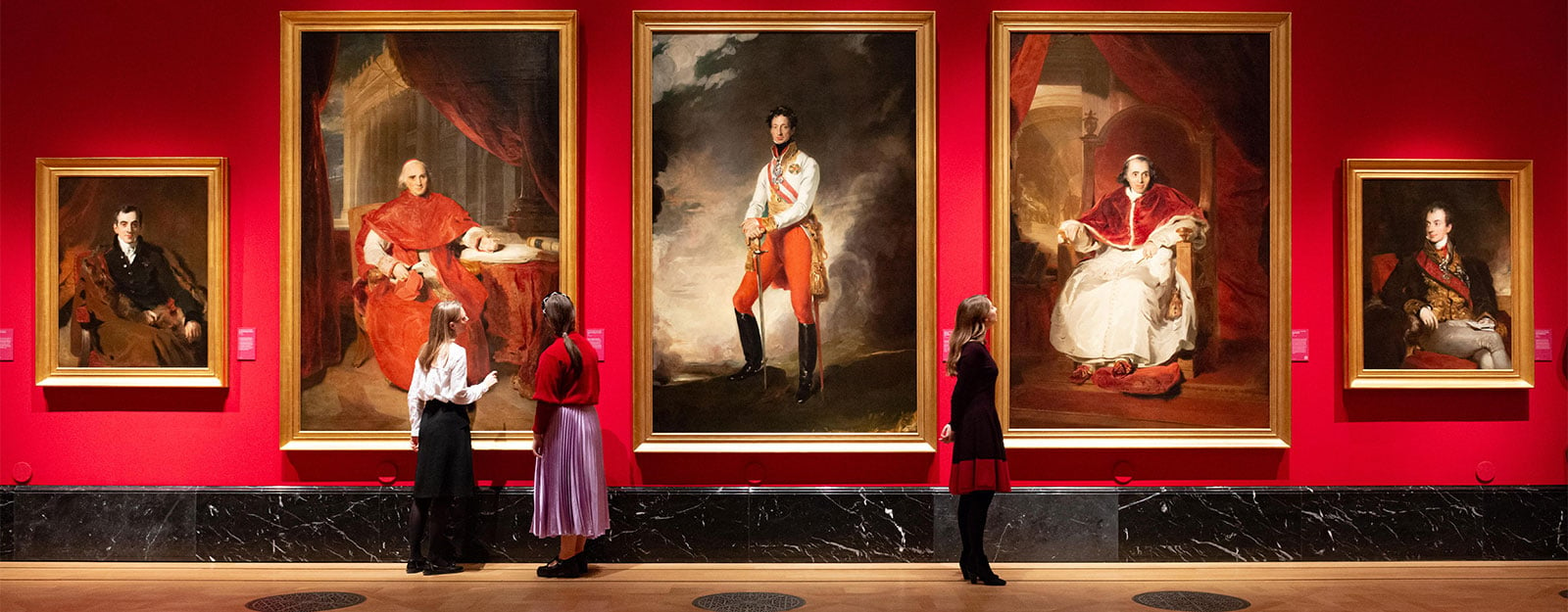
About the Collection
Learn more about the Royal Collection, one of the most important art collections in the world.
Paintings
All British monarchs have acquired paintings, but some stand out as collectors of real passion and individual taste. The status and quality of the Royal Collection derives principally from the efforts of Charles I, Frederick, Prince of Wales, George III, George IV, Queen Victoria and her consort, Prince Albert. The greatest strengths of the Collection lie in the European Old Masters, British portraiture and Victorian painting.
The most important series of works from the Italian Renaissance are Mantegna’s Triumphs of Caesar at Hampton Court and the Raphael Tapestry Cartoons on loan to the Victoria and Albert Museum. The Collection also holds beautiful examples of the work of Bellini, Titian, Correggio, Parmigianino and Lorenzo Lotto. There is a particularly rich group of 18th-century Italian paintings, including 50 works by Canaletto. There are outstanding examples of Flemish 17th-century painting by Rubens, Van Dyck and Teniers. There is also a fine group of works by painters associated with the Golden Age in 17th-century Holland including Jan Vermeer's A lady at the virginals with a gentleman and enriched by genre subjects by de Hooch, ter Borch, Dou, Metsu, Ostade, together with landscapes by Ruisdael and Hobbema.
The Royal Collection provides an unparalleled history of portrait painting in Britain, from Hans Holbein in the 16th century to Lucian Freud in our own time. Every major contributor to this great tradition – Van Dyck, Lely, Hogarth, Ramsay, Reynolds, Gainsborough and Lawrence – is represented by some of their most ambitious works. The Collection embraces many types of portraiture, from the grandest images of monarchy to Johann Zoffany’s informal ‘conversation pieces’.
Portrait painting of the Victorian age is dominated by Winterhalter and Von Angeli. Queen Victoria herself particularly admired the animal painting of Landseer. Landscapes, battle-pieces, ceremonial paintings and genre scenes record the places, events and the daily life of the British Empire in its hey-day.
History
Henry VIII employed the great German portrait painter, Hans Holbein the Younger, and Charles I attracted a range of artists to England, none more important that Van Dyck. Charles I also bought en masse the collection of the Gonzaga family, the Dukes of Mantua. When the painter Rubens visited England in 1629 he was amazed to discover a collection which could bear comparison with those in the courts of Italy, France and Spain. The king’s collection was sold during Cromwell’s Protectorate (1649-59) and only re-acquired piece-meal and in part after the Restoration.
During the 18th century Frederick, Prince of Wales and his son George III proved discerning patrons and collectors, the latter acquiring at a stroke the entire collection of the English Consul in Venice and Canaletto’s agent – Joseph Smith.
George IV added abundantly tothe collection of Dutch masters almost from scratch, but also did a great deal to encourage British art. He bought the works of recently deceased painters, including Reynolds and Gainsborough, and commissioned living artists, like the Scottish genre painter, Sir David Wilkie.
Prince Albert’s interest in ‘early’ Italian, German and Netherlandish masters of the 14th and 15th centuries, who had previously been considered ‘primitive’, was profoundly influential on taste. With the acquisition of the Öttingen Wallerstein collection, Queen Victoria and Prince Albert added works by Fra Angelico, Gozzoli, Duccio and Daddi to the Collection. After the Prince’s death, 22 of the best pictures were given by the queen to the National Gallery in his memory. Prince Albert and Queen Victoria also encouraged living artists, particularly English and German, and commissioned an astonishing range of portraits, ceremonial paintings and scenes of everyday life.
The paintings in the Royal Collection are extremely well documented. There are inventories that date back to the 16th and 17th centuries describing the works and their distribution room by room in the various residences. The display in more recent years is recorded with great accuracy by watercolours, prints and photographs. The most elaborate illustrated description is The History of the Royal Residences by William Henry Pyne, published in three volumes in 1819. Such images provide an invaluable insight into the decorative schemes of the past.







